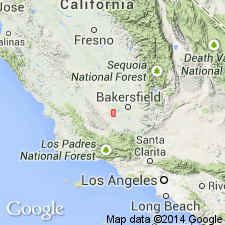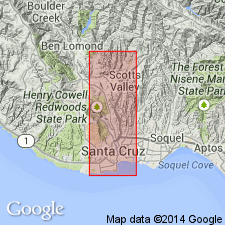
- Usage in publication:
-
- Tupman Shale Member*
- Modifications:
-
- Named
- Dominant lithology:
-
- Shale
- AAPG geologic province:
-
- San Joaquin basin
Summary:
Pg. D12-D15, D46-D53. Tupman Shale Member, lowermost of two members of Etchegoin Formation. These strata have also been informally termed "Bulliminella silt" by oil-company geologists because of abundance of foraminifer BULLIMINELLA ELEGANTISSIMA. Consists of olive-gray, silty shale with some sandstone beds. Thickness is 1,330 feet. Overlies Reef Ridge Shale. Underlies Carman Sandstone Member (new) of Etchegoin Formation. Age is Pliocene. Report includes electric log, detailed lithologic description of core, charts showing distribution of fossils. (Tupman Shale Member of Etchegoin Formation adopted by the USGS.)
Type section (subsurface): depth-interval 3,387 to 4,717 ft, Unit Operation Naval Petroleum Reserve No.1 (NPR-1) well 324-19R, west part of Elk Hills oil field, Elk Hills, NW/4 sec. 19, T. 30 S., R. 23 E., San Joaquin Valley, Kern Co., CA. Named from community of Tupman, at east end of Elk Hills, Kern Co., CA.
[Discrepancy: age of member is listed as Pliocene in this publication, and in GNC records (Changes in stratigraphic nomenclature, 1973, USGS Bull. 1395-A) and GNU records (USGS DDS-6; Menlo GNULEX); it is listed as late Pliocene in US geologic names lexicon (USGS Bull. 1520, p. 52), which is here considered a misprint.]
Source: Publication; GNU records (USGS DDS-6; Menlo GNULEX); Changes in stratigraphic nomenclature, 1973 (USGS Bull. 1395-A, p. A44-A45); US geologic names lexicon (USGS Bull. 1520, p. 317).

- Usage in publication:
-
- Tupman Shale Member*
- Modifications:
-
- Age modified
- Biostratigraphic dating
- AAPG geologic province:
-
- San Joaquin basin
Summary:
Age of Etchegoin Formation is late Miocene (International Epoch assignment) based on vertebrate evidence of otarioid fauna, PLIOPEDIA PACIFICA and Arctocephaline aff. CALLORHINUS, collected from Kettleman Hills, California. Estimated age is 7 to 4 Ma. [Mammalian Provincial] Stage - Age association is Hemphillian and "Etchegoin." [Age of Tupman Shale Member not addressed in report, but age is late Miocene based on age of Etchegoin Formation.]
Source: GNU records (USGS DDS-6; Menlo GNULEX).
For more information, please contact Nancy Stamm, Geologic Names Committee Secretary.
Asterisk (*) indicates published by U.S. Geological Survey authors.
"No current usage" (†) implies that a name has been abandoned or has fallen into disuse. Former usage and, if known, replacement name given in parentheses ( ).
Slash (/) indicates name conflicts with nomenclatural guidelines (CSN, 1933; ACSN, 1961, 1970; NACSN, 1983, 2005, 2021). May be explained within brackets ([ ]).

